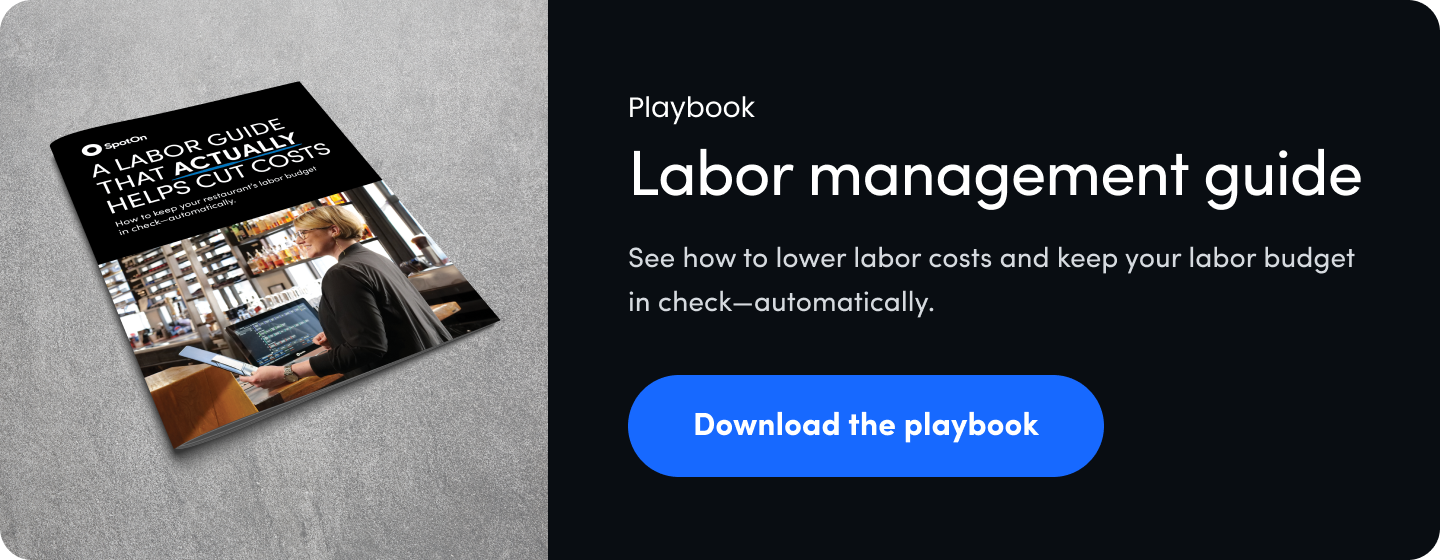I used to spend a lot of time at the Ferry Plaza farmer's market in San Francisco. I got to know the farmers, stall workers, and the other chefs who were there every Saturday, rain or shine. Chef-to-chef conversations ranged from Friday night's guest horror stories to debating where to find the best apricots. Our collective goal was to source the best ingredients, give credit to the farmers, and train our staff to tell the story of the greatest avocado ever grown. But the price of that avocado? Whatever!
Looking back, I wonder why we never spoke about the cost of goods sold, labor cost, and weekly operational budget. Certainly, it was more fun catching up with the baristas, butchers, and bakers than discussing the ideal food cost percentage. Debating preparation methods with an heirloom grain farmer was way more interesting than plugging the cost of those grains into a food cost formula.
Sourcing the highest-quality ingredients was our "why." We pushed off the real business issues until Monday. Saturdays were for inspiration, creating something unique, and earning recognition for cooking something crave-worthy. Not agonizing over your restaurant's food cost percentage.
The market was also an opportunity to bump into foodie shoppers strolling the market. I always had my business card ready to share with the real, hardcore diners willing to take a Monday or Tuesday night reservation. Funny though, no one ever asked, "How much are you going to charge for the farro salad?" It’s likely they didn’t care. What concerned them more was the $18 burger ($24, adjusted for inflation).
Ten years later, consumers are more confused than ever. Added service fees, health ordinance fees, and gratuity-included menus are now common as restaurants are looking for ways to appease their guests and keep menu prices low. The fees typically help cover a variety of labor cost increases that didn’t exist ten years ago.
Yet, restaurants continue operating business models of the past, lack creativity, and refuse to change the way they do business. To make matters worse, diners are reluctant to give up control of tipping or pay more for a burger. When does it all break?
To better understand how restaurants calculate food cost and menu pricing, let’s consider some of the drivers that many consumers do not understand when it comes to determining the real cost of a dish.
Breaking down the $18 Burger
At Hog & Rocks, the burger was our most popular menu item. It was a double smash burger with cheese, made from Wagyu beef and country ham, ground daily. We piled on caramelized onions, butter lettuce, sauce, and housemade pickles on a brioche bun.
It was widely considered one of the best burgers in San Francisco. To better understand the economics of why we charged $18, despite some guests believing that they could make the same burger for cheaper, let’s take a look at what went into the actual food cost. Spoiler alert: no one could make it for $18 at home.

Determining the ideal menu item price
Set a gross profit margin
Make a profit! Why would any entrepreneur start a business to not make money? Profits come first. Without them, you can’t put food on your family's table, pay your rent or mortgage, or afford gas and a car to drive to your restaurant. Working in the restaurant industry means running a business. Profit margins must factor into menu prices. It's non-negotiable. Aim for 10-20% of the menu price.
Consider fixed expenses
Fixed expenses are typically determined before you open the doors and must factor into your menu prices. Picking a location, negotiating a lease, buying insurance, and paying utilities are expenses that will never go away and could haunt or help you be a profitable restaurant in the long term. Include the total cost of those expenses when calculating menu prices. These could account for 15-20% of your total menu prices.

Calculate food costs
Your restaurant's cuisine tells a story. Make it a good one, and make it consistent. There are no strict rules when you set menu prices. Your menu and ingredients can range from cheap commodity ingredients to mid-range seasonal and locally sourced ingredients to expensive hard-to-source luxury ingredients. Regardless of the dish or drink, sourcing ingredients that meet the food cost budget will range from 15% to 30% of the menu price.
Prioritize efficiency
Cooking food is a specialized trade. It requires skills and years of training. That can come with a high cost, especially depending on the cuisine, concept, service type, and size of the restaurant. You can't run a restaurant alone—I could argue that labor is the number one consideration when determining menu prices. However, when it comes to labor, you can control costs per dish in a way you can't with food costs and other expenses. In this way, it can be a key to maximize profits.
From frozen fries to meat and seafood in pre-portion sizes to high-tech cooking equipment, cooking food efficiently has never been easier. Technology like KDS, restaurant management software, and inventory management software can also be assets in this department. During a time when average labor costs range from 30% to 45%, depending on city and state labor laws, labor efficiency has never been more important.

It's not just food costs
Nailing the food cost percentage, controlling labor, and considering fixed expenses is crucial. But there are more factors at play. Here are some ways many restaurants can struggle to achieve a realistic food cost without inhibiting food sales or getting saddled with unprofitable menu items.
Hidden complexity
Restaurateurs face complex cost structures, and most consumers are unaware of the interplay between food costs, labor, fixed expenses, and profit margins. Calculating your food prices requires many delicate decisions, including negotiating with vendors and menu engineering and planning. Without a restaurant pos system to provide detailed, accurate reporting, the task of calculating food cost percentage and inventory value becomes exponentially more difficult
For most restaurants, this process is behind the scenes. It's what makes the dining experience appear so effortless to the average guest. Restaurants are great at keeping the hard part of the business in the shadows. It can be an advantage, giving restaurants the appearance of a duck calm on the surface but paddling madly underwater. But it can also be a disadvantage when it comes to communicating the total value of your menu items.
Guest misconceptions
Many consumers believe that restaurant pricing strategies are based solely on food costs without considering labor costs and fixed expenses. The former expense continues to increase in cities and states across the country, leaving restaurateurs with no options to raise prices.
Many consumers believe that restaurant pricing strategies are based solely on food costs without considering labor costs and fixed expenses.
Limited information and education about how the business works, let alone menu pricing, often cause misconceptions about success and profitability. Very few people “get rich” owning restaurants as profit margins are thin to none for many.
The existing market
Restaurants exist in the context of the neighborhood around them. Trendy restaurants opening in rejuvenated neighborhoods can struggle to demand higher prices. Customers often have the expectation that they should pay less or more according to the type of restaurant or location.
Higher prices don’t always mean higher quality. Brand reputation and positioning can influence how menu item prices are perceived. When guest expectations aren't managed properly, a restaurant can fail. For example, guests expect high-end restaurants serving American or European cuisine to charge more due to their perceived exclusivity. Other international cuisines are expected to be cheap but are just as expensive and labor-intensive to make.
Perceived Value vs. Actual Cost

More than coming up with the concept or assembling the burger, educating diners about the actual food cost was the major challenge. With tickets stacking up on the rail and the line cooks on rapid fire making as many burgers as possible, it was crucial we kept our quality standards high. Cutting corners or sandbagging them was not an option.
That burger was on “best of SF” lists and had a reputation to uphold. Each one had to be cooked and constructed consistently. This was the reason they came to my restaurant! Build a bad burger with a premium price, and we were never going to see that first-timer again. Make it perfect, and we will see them again next week.
The cost of PR and digital marketing
In addition to keeping up with a daily flow of tickets, restaurants must uphold their brand and reputation through PR, digital marketing, loyalty programs, and special offers. These tools are table stakes in acquiring guests and earning repeat visits.
Most successful restaurants maintain large budgets, especially during slow and peak times of the year, which can be costly. This is especially true with new restaurants opening in larger markets with fierce competition. Building an initial customer base, using promotions to meet sales targets, and sponsoring local events to engage with the community will always be reflected in the menu prices. But, it’s a wide range and has many variables, so expect restaurant marketing expenses to take up 2-50% of the menu price.
Restaurant design and concept
Most restaurants require an immense amount of capital to get to the grand opening stage. Custom furniture, thoughtful design, and commercial-grade equipment are expensive to purchase and maintain over time.
The initial investment of all this when opening a restaurant can impact the price menu items can command. Simple restaurant designs built on a shoestring budget will struggle to command higher prices, while luxurious dining rooms will have more room to increase prices. The restaurant's design—both aesthetic and operational—determines the average price a restaurant can charge for the entire meal.
When restaurants pay the bill
People love going out to eat. Restaurants currently loom large in our culture and remain extremely popular. From local dive bars to romantic dinners for two at a fine dining concept, restaurants play an essential role in our daily lives. They’re run by people, owned by people, and serve the people.
But, many diners still don’t understand how complicated the business truly is. Determining menu prices is complicated work. Decisions can generate intense scrutiny from staff, fellow operators, and guests alike.
Most restaurant owners are in the business of serving others and creating a memorable experience. They're not price-gouging scoundrels trying to overcharge regular people. We must better understand the business dynamics before complaining about why a local restaurant charges $18 for a burger that's $8 at some fast food restaurants. All restaurants are created differently, and it’s up to them to set expectations and exceed them when possible. We’ve all been to that restaurant when you paid for more than what you got. And that is not the price anyone wants to pay.













